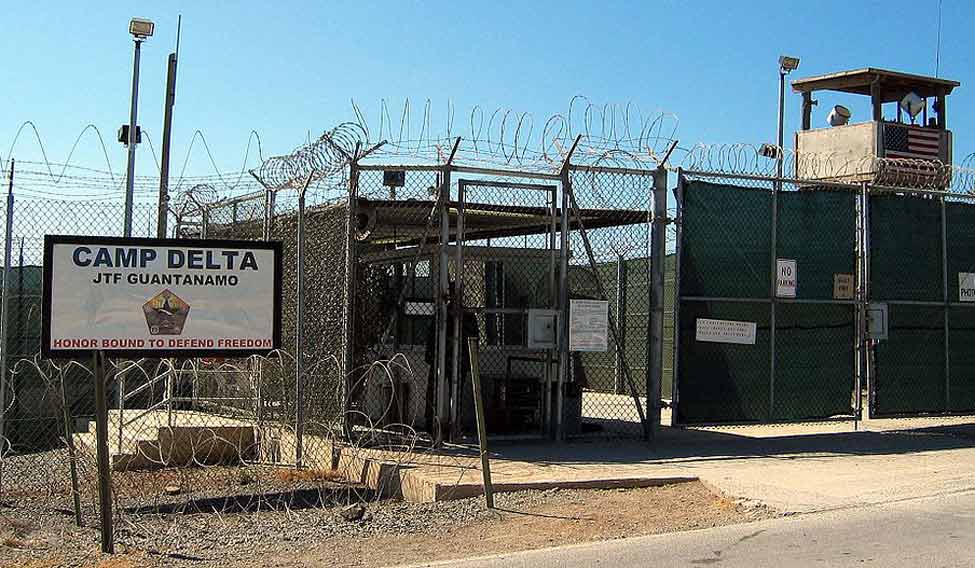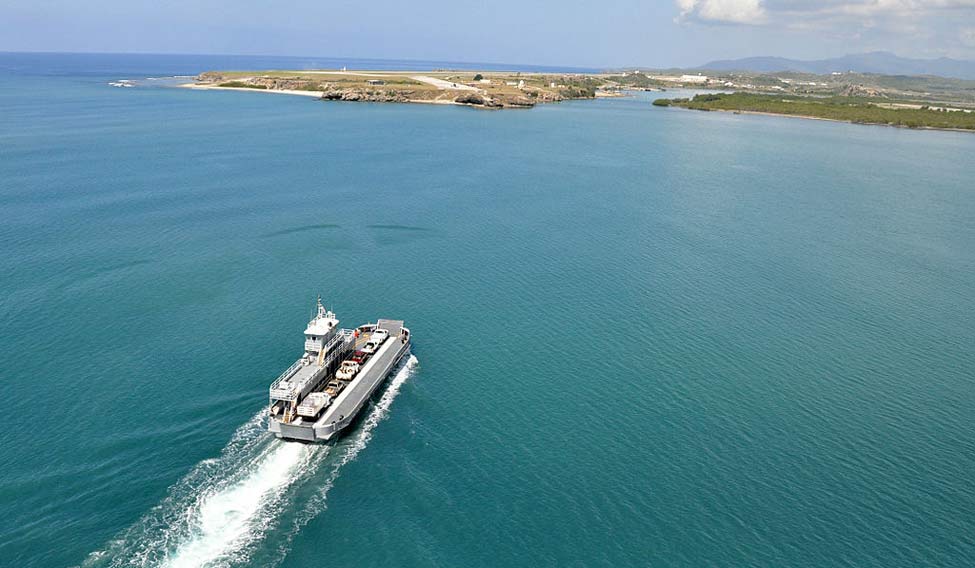After the plane landed, a bus took us to a ferry, and beneath it we felt the sea. We were tired, hungry, in pain, and in fear about it all. We were gagged, blindfolded and shackled. We were dragged from the ferry to our cages. When we arrived at our cages, we whispered to one another, “There is a sea around.” We could feel it despite all of the pain, confusion and fear. All we were waiting for at the beginning was the sea.
Few detainees had seen the sea before coming to Guantanamo. All that the Afghans knew was that it was a lot of water that kills and eats people. They started asking about the sea. People who knew what the sea was, mostly people like me, from Arab countries, tried to explain it to the Afghans, but that made them even more afraid.
An Afghan pointed to a cargo plane, and said, “The sea is big like this?”
Bigger, he was told. “Ships can carry many planes that size,” another detainee said.
The Afghans told other detainees that the American interrogators threatened them, saying, “When we finish with you here, you will be taken to the sea, and you all will be thrown there.” It wasn’t a good beginning with the sea.
When we arrived, the first thing we wanted to know was our location. As Muslims, we pray five times a day, and we must face the Holy Kaaba in Mecca. The direction toward Mecca was impossible to determine when we first got to Guantanamo.
Detainees started to consider the facts available: the weather, the birds, the sea. Then, anything that would tell us about our location. Even dreams. One detainee said, “Based on my dream, we are in Oman.” Some guessed we were in India because the pipes that held up our cells’ fences had “Made in India” written on them.
Finally, after many months, some detainees who were arrested after Guantanamo was known about were brought in. They told us we are in Cuba, in Guantanamo. Some of us might have heard of Cuba, but never Guantanamo. Some detainees wouldn’t believe it. In the beginning, it was hard for us to pronounce that name, or even memorise it.
All we knew was there was the sea.
Some of the camps in Guantanamo were closer to the sea than others. After a few months, we were moved from Camp X-Ray to Camp Delta, which was closer to the sea, but we weren’t allowed to see it. The many fences around us were covered with green tarp to block us from seeing the sea. Once, I tried to tear off the tarp, but guards saw me and I was sent to isolation. We tried many times to tear off that tarp. When we did, we saw that there were more walls of fences and tarps, so it was useless.
People will do anything to take their minds away from hell. To remind themselves that a world beyond the hell of Guantanamo still existed, we wanted to show the Afghans the sea. No matter how we described the sea for them, we knew they must see it for themselves. We got some magazines to show them what it looked like. “A lot of water,” they said. “How can it carry those ships?” We explained to them about earth and the proportion of the land to the seas, the rivers, the oceans, how ships sail on water and what kind of ships.
Years passed, and we missed everything in our lives.
 Camp Delta at Guantanamo Bay, Cuba | Wikimedia Commons
Camp Delta at Guantanamo Bay, Cuba | Wikimedia Commons
It was hard not seeing the sea, despite it being only a few hundred feet away from us. At the recreation area, if we lay on our stomach, we could get glimpses of the sea through small openings below the tarp. When the guards found out, they blocked the openings. In some cells, in some blocks, we could stand on the windows at the back of our cells to see the sea, but that was risky, because the guards punished us every time they saw us standing and looking out. Whenever any of us wanted to look at the sea, we needed to ask one of the other detainees to watch for the guards and warn us if they came around the block. It wasn’t long before the administration made higher covers, blocking us from seeing the sea. When we asked why, we were told it was for security and safety.
We couldn’t see more than 30 feet beyond our cells at best—walls, fences, green tarps covering everything. I remember how those who couldn’t see the sea kept asking the others to tell them what they saw.
But something happened in 2014 that let most of us, finally, see the sea. News that a hurricane was headed toward Cuba caused camp administration to take down the green tarps that blocked us from seeing the sea. The detainees looked so happy when the guards started taking down the covers.
We all faced one direction: toward the sea. It felt like a little freedom, to look at it. I heard an Afghan guy shout, “Allahu akbar!” at the sight, thanking God for the wonder of the sea, repeating that many times, calling out to his friends.
The tarps remained down for a few days, and the detainees started making art about the sea. Some wrote poems about it. And everyone who could draw drew the sea. I could see different meanings in each drawing, colour and shape. I could see the detainees put their dreams, feelings, hopes and lives in them. I could see some of these drawings were mixtures of hope and pain. That the sea means freedom no one can control or own, freedom for everyone.
Each of us found a way to escape to the sea.
Those who could see the sea spent most of their time watching, listening and looking at that big blue colour, which cools our souls. The sea was a little rough, because of the windy weather. Huge waves that rose high and hit the land. Looking at a sea like that was scary, but it was what we got, and it felt good. Afghans started calling out to one another and expressing their feelings about what they saw, and turned to us with many questions about that beast.
Those days without the tarps were like a vacation. On the last day the sea looked refreshed, calm and lovely. A huge ship sailed close by. Detainees called out to one another to look at the ship. We kept looking at it like something magic would happen and all of us would be freed. But the ship just disappeared. The next day the workers returned and blocked our sight.
Mansoor Adayfi was released from Guantanamo in 2016 and is at work on a book about his detention. This essay is adapted from the catalogue for Ode to the Sea: Art From Guantanamo Bay.






